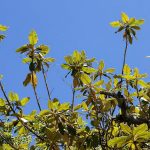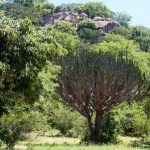TREE LIFE
JULY 1988
HARARE CALENDAR
Saturday 2nd July : Botanic Garden Walk. Meet in the Car Park at 10.45 for 11.00am.
Sunday 17th July : Hugh Charters, Erene Farm, Marondera, where a dam has been built between two kopjes which are very rich in vegetation including Aloe excelsa of tree size and, we hope, which should be flowering at that time. Express Motor-ways coach has been booked which will depart from Monomatapa Car Park in Park Lane at 8.15 am. A security guard will look after left cars. Fare is $17,50 Please phone your bookings to Joy Killian on Harare Phone No. 308398 if possible by Thursday 14th July.
Saturday 23rd July : Mukuvisi Woodlands Meeting. Meeting at 3.00 pm. at Paget Road/Inyanga Crescent gate.
Saturday 6th August : Botanic Garden Walk at 10.45 for 11 am.
Sunday 21st August : Goromonzi / Ruwa – Dr. Everard Cock
1st and 2nd October : Outing to Inyangani. Dr. Chris Trace has offered to accommodate up to 12 members at his “piece of Inyangani”. He offers spectacular views and magnificent forest. Anyone interested in joining this party should contact the Chairman before 15th September.
ALOE 88 : INTERNATIONAL SUCCULENT PLANT CONGRESS
An International Succulent Plant congress (short titled ALOE 88) will be held in Harare from Monday 18th July to Sunday 24th July 1988.
The Congress will comprise – a) 30 one hour lectures, illustrated by slides, by international experts drawn
from l5 countries in Africa, Europe, Asia and America, covering –
i the succulent flora and plant habitats of several countries including Zimbabwe, Angola, Kenya, Somalia, Sudan, Botswana, Arabia, USA. etc;
ii the botanic gardens of Palarmo (Italy) and Frankfurt (West Germany);
iii National Parks in the USA ;
iv surveys of and introductions to plant families including the Stapeliesae
and the Euphorbiacea;
v other topics
a) an all day habitat visit and photo safari to the Great Dyke and its unique flora.
b) Visit to the National Botanic Garden and Ewanrigg Botanic Garden, as well an to Springs Farm to view a large private succulent plant and cycad garden.
c) several social functions
d) post congress habitat tours in the Hwange, Bulawayo and Masvingo areas.
Members of our Society have been invited to register as delegates to this Congress.
The coat of Registration, which covers a,b,c, and d above, is $60 for non-ACSSZ members or $50 for those of our members who are also members of the Aloe, Cactus and Succulent Society of Zimbabwe.
Registration Forms and further details are available now from the Convenor of
ALOE 88 (Mike Kimberley) at PO Box 8514, Causeway.
For those of our members who cannot participate as full delegates, but who wish to attend the lectures only some of them, a special lecture only fee of $12 is payable either now or at the ALOE 88 information desk at the Great lndaba Room, First Floor, Monomatapa Hotel, Harare, where all the lectures will be presented, from Monday 18th July 1965 onwards.
MATABELELAND CALENDAR
On Sunday, July 3rd we go to the Matopos. Meet at Retreat, at 8.10 am. Cars duly arranged. Bring Lunch.
On Sunday 7th August we go to the Khami Ruins area. Meet just beyond Modern Motors on the Khami Road. This will be a shorter outing.
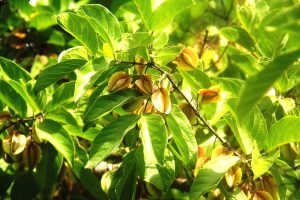
Combretum apiculatum. Photo: Bart Wursten. Source: Flora of Zimbabwe
On Sunday, June 12th we went to Falcon College to their noted Conservation Area, Quiet Waters. We drove over quite a bit of dirt road to get there, along the Homestead Road. Candidly this would have been better reduced, by sticking to the tar, through Esigodini, very little further, and better going. However we all had a very good day, joined with the Aloe and Cactus Society, who also produced a very fine lunch. We saw a lot of well-leaved trees, a lot of dam water and even ducks, quite a contrast from our last visit. Though I’m afraid we knew few aloes, we identified some 50 tree species : Acacia, well represented A. siebierana, A. fleckii, A. gerrardii, A. karroo, A. chariessa, A. nigrescens (very knobby thorns, these) A. rehmanniana, Albizia amara, Azanza garckeana, Bolusanthus speciosus, Burkea africana, Carissa edulis, Cassia abbreviate, Cassine matabelica, C. transvaalensis in bud, Combretum apiculatum, C. hereroense, C. imberbe, C. molle and very like it, but clearly RUBIACEAE family, Crossopteryx febrifuga, some pinkish petioles quite prominent, many rubber trees, Diplorhynchus condylocarpon, Dichrostachys cinerea, Dombeya rotundifolia, Euclea divinorum, showing some variation in its leaves, Ficus glumosa with very wide leaves, F. ingens, Grewia bicolour, G. flavescens still flowering and heavily in fruit, G. monticola, Lannea discolour mostly already leafless, Maytenus heterophylla, M. senegalensis, Ormocarpum trichocarpum covered with hairy caterpillar pods, Ozoroa insignia, subsp. reticulata, Parinari curatellifolia, Pavetta schumanniana, a Phyllanthus (now Margaritaria), which had been identified as P. kirkianus, though it does not seem to occur in the area, so I though it P. discoideus (now Margaritaria discoidea), Bauhinia (Piliostigma formerly) thonningii, Pterocarpus angolensis, (some fine specimens, P. rotundifolius, Strychnos spinosa, Tarchonanthus camphorates, Terminalia serices, T. trichopoda, Ximenia caffra and Ziziphus mucronata. The grass being fairly long, we stuck to the roads, mainly and did not penetrate far in, so there was a good deal more to see.
-C. Sykes
19th AUGUST : AGM AND OUTING : LAKE MCILWAINE
To recover from the strain of the A.G.M the 45 members present went into the bush adjacent to Harare Sports Yacht Club and found serenity amongst the modest variety of trees that grew there.
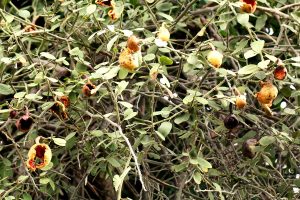
Capparis tomentosa. Photo: Bart Wursten. Source: Flora of Zimbabwe
It soon became apparent that the good rains during the last season had produced a healthy crop of fruit. We found Capparis tomentosa with its large round fruit hanging on their long stout stalks. The wind rustled the circular pods of the Pterocarpus angolensis, devoid of leaves but laden with fruit. Swartzia madagascariensis had plenty of pods, in shape bringing alive the common name ‘Snake Been’. We found Dichrostachys cinerea laden with clusters of contorted pods, and Peltophorum africanum with clusters of more sedate, conventional pods.
We also found a good crop of black-jacks and other not-so-welcome adherents.
While admiring the speckled fruit of Strychnos cocculoides we learned that only two species of Strychnos are protected by spines – cocculoides and spinosa. The different texture of the bark tells which is which. Simple when you know how, we learned later while trying to catch a whiff of Clerodendrum glabrum (which often smells foul but today didn’t) that the narrowly striated bark that we were looking at is typical of trees of the family VERBENACEAE, of which Clerodendrum, Vitex, and Holmskioldia are the best known genera. And we learned from examining Maytenus senegalensis in flower that pollination is carried out by flies – maybe the bees and butterflies don’t like the cold weather during which this species often flowers.
And so the magic of the bush was unfolded for us once again. Our thanks to the sailors for allowing us to use their woodland, and facilities, this day.
-D.Hicks
CHAIRMAN’S REPORT : JUNE 1988
Another year has passed, another year during which Members have continued to enjoy the bush in general, and the trees in particular, in their own way. Your Committee in Harare has tried-to choose venues which offer something for everyone – a good variety of trees, attractive scenery, and economical outings. This latter factor has been of particular concern and will continue to be so as inflation creeps insidiously into all aspects of life. If the mere distant outings prove to be too expensive for most members, then we will have to consider whether or not they should be continued in 1989. Such a move would not necessarily spell the end of studying interesting trees. For instance, there are over 110 species to be found on the Concession kopjes, surely enough to blow most minds. However please let us have suggestions for venues for 1989.
For those who cannot attend monthly outings regularly, your committees sets great store on publishing an interesting and informative Tree Life each month. Phil Haxen is the one to whom our thanks are due for his success in making bricks without straw – he has a battle every month assembling enough material and I would like to appeal to all members to contribute whatever they can for publication. A second appeal now, Phil would welcome the opportunity to pass this chore onto someone else, so if anyone would like to volunteer to assist Phil with a view to taking over eventually than we would be most grateful.
During the past year we have had several opportunities to reach out to other bodies who, for a variety of reasons, wish to know more about trees. Dick Petheram offered his knowledge to a group of Game farmers, who had an interest in browses trees – Meg and Kim are deeply involved in producing a leaf key for the Zambezi Valley. Phil found himself identifying trees at Peterhouse School for the benefit of pupils and other visitors to their private Nature Reserve, and Meg went to Masvingo to carry out a similar exercise for the Masvingo Branch of the Wild Life Society.
I am personally in favour of this kind of activity, indeed I would go further and suggest that the more one learns about the geology, flora and fauna of the bush as a whole, so one’s appreciation of the trees is enhanced. I would welcome any association with other bodies that would enable us to share knowledge and understanding of the environment in which we live. This, for me would extend to a study of rock painting, for the people who executed them must surely have had an understanding of the bush which will never be reached again and which was lost when the hunter/gatherer society to which they belonged was eliminated. So if any member has specialised knowledge of epiphytic orchids, or grasses, or birds, and would like to share this with us, then please come on an outing and we will give him or her the floor with the greatest of pleasure.
Several members of your Committee are standing down this year. Maureen Lumholst Smith, has sold the field cards and kept the outings register for more field trips than she can remember. Molly Kilpert has been the recorder and has put many a tick on many a list over the last few years, but has undertaken to collate Tree Life every month instead. This task has, up to nor, been carried out by Georgie Granelli, but she also has decided that enough is enough, and our thanks go to these ladies for their help in keeping the show on the road. My thanks also to the Harare Sports Yacht Club for the use of their excellent facilities for this Meeting.
Now is the time for me to thank the Committee in particular and the members in general for making my first year as Chairman a pleasant one, and to formally stand myself and the Committee down with our offer to continue for another year if members so wish.
D.Hicks Chairman
BOTANIC GARDEN WALK : Saturday 4th June 1988
This month we looked at the “Forest Outlyers,” those species which grow at the edges of forests or occupy buckets of higher mist or rain in otherwise drier areas. The species structure of these outlyers is usually quite different to that of the true forest.
We first examined Ficus sansibarica, which is quite easily confused with F. chirindensis.
The fruits, Tom told us, are quite different, but without comparing them, I’m not sure of the differences F. sansibarica bears fruits on the branches. In passing we noted the Zimbabwe creeper in flower. It is often grown as an ornamental, but grows so large that it may become a problem.
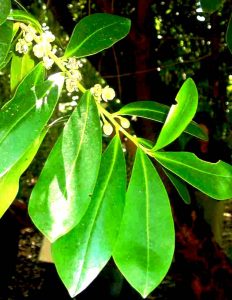
Warburgia salutaris. Photo: Bart Wursten. Source: Flora of Zimbabwe
The Gardens have at least four well developed specimens of Warburgia salutaris (Pepper-bark). This species is extremely rare, not only because the habitat is rare but because it is one of the most versatile of the traditional medicine plants, having uses in a wide variety of ailments. Unfortunately, the most useful part is the bark, so trees tend to be felled. It is doubtful if any mature trees now exist in the natural habitat, but thanks to Tom’s success with cuttings, we can still savour the hot peppery leaves reputed to help sore throat.
Cassipourea euryoides one of the onionwoods. The genus belongs to family RHIZOPHDRACEAE, the mangrove family, but none of the Cassipoureas occur in mangrove swamps. This species was once incorporated with C. malosana which occurs in the Vumba forests, but C. euryoides is always a forest outlyer. The species was one of those under suspicion for altering the sex of chickens run on the sawdust (Hens became cockerels, a disaster for egg production) however it later appeared that the substances responsible for the hormonal upheavals, derived from fungus growing on the sawdust, not the sawdust itself Cassipourea could be mistaken for a RUBIACEAE as it has the interpetiolar stipules, but these fall early, and the sharp serrations or the leaf margins eliminate possibility of RUBIACEAE.
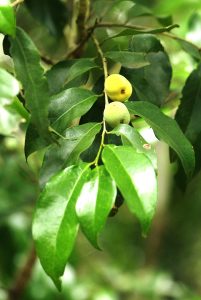
Drypetes reticulata. Photo: Bart Wursten. Source: Flora of Zimbabwe
We saw Drypetes reticulata (family EUPHORBIACEAE) a rare plant from the Chipinge area, and Apodytes dimidiata with its reddish petioles and young branches. Oreobambos buchwaldii is one of our indigenous bamboos, occurring on Mount Buchwa near Mberengwa formerly Belingwe. In the gardens the entire clump of the bamboo flowered a few years back, produced seed then died. This is typical of many monocotyledens – bananas, some palms, agaves etc – which bear a terminal flower, fruit or seed profusely then die. Seedlings of Oreobambos are now caning up all over the area.
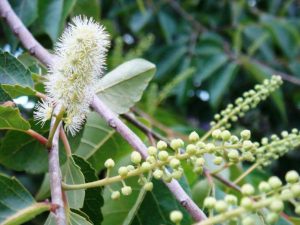
Bivinia jalbertii. Photo: Maureen Silva Jones. Source: Flora of Zimbabwe
Also from Mount Buchwa is Turraea floribunda, and from Myoni Hill, Turraea abtusifolia (family MELIACEAE) in flower. Tom pointed out the stamen tube, characteristic of the genus. Bivinia jalbertii (family FLACOURTIACEAE) is a tree of the Nyoni Hills, where it grows in the gulley ecotone, and is a truly forest edge species. It has been very heavily utilised due to its growth form, with a very straight central trunk, suitable for building or poles. The wood is also very durable. This tree seems to be endangered in its habitat, but is now being grown in plantations. Other species included in the walk were Strychnos henningsii and S. decussata, Terminalia gazensis of Christmas Pass, Heteropyxis dehniae (Lavender Tree), and Maytenus mossambicense covered in small red fruit which open to drop bright orange seeds.
A more surprising member of the group is Androstachys johnsonii, the ironwood of the Southeast Lowveld. It is highly drought resistant but grows into wet hills where it grows to 20m. Remaining species in the group shown to us by Tom, but which would take too long to describe here are, Oxyanthus speciosus, Canthium setiflorum, Maytenus undata, Scolopia zeyheri, Tricalysia congesta, Olinia vanguerioides, Homalium dentatum, and Stadmannia oppositifolia.
-C. Haxen
JOINT OUTING WITH THE MASVINGO BRANCH OF THE WILDLIFE SOCIETY 28TH – 29TH MAY
Four of us went to Masvingo with the object of introducing, members of the Wildlife Society to the identification of trees. We found that this very dynamic branch were in the process of creating their own Nature Reserve on the edge of Masvingo, which will be known as Shagashi Nature Reserve. The bulk of the area will be used to allow a few species of buck to be penned, and the remainder as a recreational area for walking and nature study.
During the course of our visit we identified 60 species of trees, the most unusual of which were Carissa bispinosa, Cordia grandicalyx, Dovyalis caffra, Olea europaea, Olinia vanguarioides, Rhus chirindensis, Rothmannia manganjae and, never to be forgotten Spirostachys africana. We have been asked to go again to carry out an identification and labelling exercise along the foot paths, and to carry out a thorough survey with the object of producing a limited species leaf key similar to that which Meg has created for the Mukuvisi Woodlands. Members will be notified when this is arranged.
CHIRUNDU MAY 21ST – 25TH 1988
Only 13 people managed to take advantage of the wonderful opportunity to visit the Zambezi Valley. A group of people of diverse interest, we all shared the desire to enjoy learning more about trees and we were continuously, both refreshed and in awe of the beauty which invaded our every sense whether by day or night.
After unpacking, a job mostly done by the first arrivals, we received lesson one from Chris Trace our hunter who soon became known as our “watchman”. If we came face to face with an elephant we must run, preferably up hill -elephants like to see you run. For a lion stand your ground and look him in the eye and for a buffalo get up the nearest tree or roll into a ball. Thus armed we were ready for anything but fortunately come no closer to a lion than a roar or two and were in the Landrover when we met elephant. As we were really too noisy for the animals though we followed many an elephant or hippo path and even saw a rhino scrape. One person was very thoroughly bitten by something unpleasant but we did not hear or see many mozzies.
Day 1 and our 12 hour expedition had something for everyone. After a dawn start we went on Kim’s triangular drive from Chirundu to Nyamuomba Corner and thence along the foot of the escarpment and back along the old road to camp. We stopped at hunting camps “A” and “B” to look at trees and to eat our picnic breakfast. Excitement number one was to hear that a poacher had been shot that morning and another wounded. We could see clearly how despite 20 years rest the compacting of soil under the trees had prevented regrowth of vegetation. Next stop was to stand on the hill at Nyamuomba corner where the river emerges from the Kariba Gorge and widens onto the flood plain. 100 feet below a long line of hippo were basking in the sun like bathing beauties on the beach (except that one was heavily scarred from a supremacy fight and a baby was bothering everyone). On a walk we soon had some of the party wallowing in the river like the hippo. Here we collected some snacks for supper. The leaves of Triplochiton zambesiacus, a tree unique to this area proved to be excellent fried. Later we saw garnets in a stream bed and came on an Acacia robusta across the road where an elephant had been before us, and had to find a way round. We saw elephant up ahead just as a Strychnos needed to be identified but any slight tension between animal and tree enthusiasts was immediately dispelled by coming act of several mothers with suckling calves for whom we had to wait while the sun set. Then hone again through positive and negative thermal to cold beers and a splendid supper. Our other days took on the pattern of rising at dawn for a cup of tea and one or more of Ann’s rusks and then off for a walk either river wards or up on the hill, back for a rather late breakfast or early lunch. Homework, perhaps a sleep, tea and off for another treeing session. Liz Trace was surprised at how little distance we covered as Chris normally strides through the bush at great speed but he soon learnt that we must wander from tree to tree ‘like little dogs’ to quote a member of the party.
Kim’s key is the result of many hours of hard work – for us it was tremendously interesting – not only did we improve our botanical knowledge and tree recognition but we felt that we were helping in a small way to make it a usable document for the layman. There was never a shortage of volunteers to key this one simple or compound? … ‘margin entire? …’. We all worked hard and we all enjoyed much merriment – I’ve been attacked by Acacia ataxacantha. We had plenty of interesting chat and pursued our own interests too – birds; ‘its a saddlebill’, butterflies; animal teeth; ‘have you-got a hammer?‘ dung beetles and other creepies; ‘look at this amazing creature’; listening to the noises of the night; ‘did you hear the scops owl?‘/hyena/lion – or just enjoying the incredible quality of light at sunset with the trees silhouetted against the horizon.
The camp is situated in a splendid setting at the foot of Chirundu Hill – a place with a magic of its own -looking down on part of the old river course about 1 km from the river itself. It is primarily intended as a camp for schools and is very well equipped with gas cooker and freezers as well as beds, mattresses and most importantly mosquito nets. Shorty is the very cheerful general factotum with an enchanting little family. All this plus 5*catering (thank you Meg) and good company – what better way to spend time amongst the trees?
-Helen Foot
MONDAY . We arose early on Monday morning and after quick cup of coffee we followed Chris Trace on a brisk walk in the river vegetation close to camp. The following account was compiled by Kim and Anne.
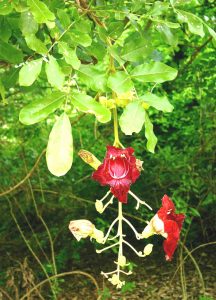
Kigelia africana. Photo: Bart Wursten. Source: Flora of Zimbabwe
The school camp overlooks an abandoned channel of the Zambezi with a short grass and tall Vetivaria. Beyond this is an established island with the typical flood plain woodland which is rare between Kariba and Chirundu but becomes important downstream. These trees include Acacia albida, Kigelia africana, Lonchocarpus capassa and Trichilia emetica. Most of the A. albida at this point are well developed with few medium sized trees. Seedlings occur round the edge of the island and the few adolescents are very spiny and have no distinct trunk. We were able to see the unique combination of straight spines and spike flowers on A. albida as the trees were in full bloom. Here too we found a Maytenus with small dark green leaves that had no hint of a blue waxy covering nor any pink to the petiole. The spines were long and green and the serrations fine and regular. This is apparently not M. heterophylla, it is apparently a form of M. senegalensis. The flowers on the latter are unisexual and may occur on different trees, those on M. heterophylla are bisexual. The latter is not reported from the Valley. Passing back through the Vetivaria we found an enormous Piliostigma thonningii and Gardenia volkensii, neither of which are common in the Valley. Here they were growing in fine sediment that is typical of over bank deposit during flood tide.
We then spent a while looking at a tall Ficus bussei along a seasonal pool and, using binos, examined the many Lonchocarpus capassa on the far bank. Heading towards breakfast we stopped at a tall flat-topped Acacia which I was so hoping would be the illusive A. kirkii, but a few pods and a number of fallen leaves led Meg to identify it as A. sieberiana, a species I had left off the key, I don’t know why.
The afternoon run saw us speed our way up Chirundu Hill. We stopped near the gate to test the key out on Markhamia acuminata and Combretum obovatum. The lower slopes contained thickets of Holmskioldia tettensis and Merostamon tatrandrus. Meg had made an interesting discovery, when the leaves of Combretum albopunctatum are held up to the light they have many pellucid dots. Similar translucent dots are not found in other species although these may have white scales on the under surface. Possibly this is why the species is called C. albopunctatum. We were fortunate enough to find leaves on Commiphora karibensis and confirmed the fact that the slash was transparent and not an opaque white as it is in Commiphora mollis, this is important as these are easily confused when leafless.
Once across the channel the visibility improved as we noted that tall grass line created by elephant who prune the A. albida while looking for seeds. The bark was also deeply scarred by elephant, these masochistic trees pay a high price in return for seed distribution by large mammals. The tall graze line on A. albida is well contrasted with the low impala graze line on the densely leaved Trichilia emetica. Impala are catholic feeders and change their diet depending on what is available. As we made our way towards the banks of the Zambezi we were keen to see the hippo which we had heard tearing at the grass so close to camp the previous evening. But this stretch of the river is fast flowing without suitable sand banks. Back through the long grass and we negotiated deep elephant footprints in mud that was now hard and black.
We then sat and watched the many ducks swimming around amongst the water lilies and water lettuce in a seasonal pool. Beneath a tall Acacia we found a finely woven bird’s nest and while looking for fallen Acacia leaves we saw a darkly coloured Charaxes. These large high flying butterflies can be trapped using a bait of rotten bananas or lion dung.
On the way to Chirundu Hill we stopped to photograph a large crocodile that was sun bathing alongside a pool near the gate. It eventually slid into the water. Nearby we found dried flowers that resembled Chinese hats but before we had progressed very far we heard the hollow grunts of lion remarkably close to where we were standing. These sounds have a metallic ring that can be mimicked by grunting with your head inside a metal bucket. But these sounds were no joke and far too close for comfort. The overdose of adrenalin had everyone scurrying up the mountain in silence with Chris and his weapon in front while Elizabeth guarded the tail end of the party with her stealth, courage and experience. It is remarkable how soon people forget that they are in a lion cage and become distracted by the trees once again.
Also on the hill were Vitex petersiana, tall Lannea schweinfurthii, Grewia flavescens, Combretum celastroides, Dalbergia martini, Strophanthus kombe and Pterocarpus lucens. Climbing the hill was greatly assisted by the well defined hippo paths, it is quite remarkable to what height these animals climb.
GENERAL GUIDE TO GENERA NO.2
The first time I ever heard of interpetiolar stipules was a year or so back when, on one of our Sunday outings, Pat Kleyn mention them as a diagnostic feature. Our group was examining a specimen of Canthium at the time and I was enchanted to learn that all genera of the family RUBIACEAE exhibit this feature. The RUBIACEAE have simple opposite leaves with margins that are entire. As far as I can establish there are no other genera not members of the family RUBICEAE which have simple opposite leaves and interpetiolar stipules except a few specimens of CASSIPOUREA and the stipules of these species fall early and are not usually observable.
Three parts of a complete leaf are the blade, the petiole and the stipules (usually 2). Stipules are appendages occurring on each side of the base of the petiole (or leaf stalk). (We are unable to produce the line drawings which are in the original Tree Life).
Interpetiolar stipules are modifications of stipules. They can only occur on the petioles of opposite leaves and what happens is that the outside edges of the stipules that face each other are joined together, giving the appearance of a single stipule between the petioles. Thus the four stipules that would normally arise at the two points of leaf insertion become two stipules between the two points of leaf insertion.
These interpetiolar stipules are easily seen on the leaf-bearing branches of all species of RUBIACEAE which is a very large family and well represented in Africa. Among the genera belonging to this family are : BREONADIA ROTHMANNIA TAPIPHYLLUM DINOCANTHIUM TARENNA TRICALYSIA CANTHIUM PAVETTA GARDENIA VANGUERIA PLECTRONIELLA
The three genera with the most species are PAVETTA, CANTHIUM AND GARDENIA. A few pointers about these three might help further in identification.
- All PAVETTA species tend to have black bacterial nodules in the leaf blade. These nodules are easily seen if the leaf is held to the light.
- Branches leaving the stem in GARDENIA species do so in whorls of threes.
- The arrangement of the branches leaving a stem in CANTHIUM species tends to be very regular. Always in opposite pairs and pairs always occurring at a 90 degree angle to the previous pair, so that if one were to look down the length of the stem one would see something like an X.
CHIRUNDU – THE 3RD DAY
Distant booming of the ground hornbills heralded this Zambezi morning, and the call of the fish eagle filled our cup of pleasure as we filled our inner persons with coffee and cookies for an early start.
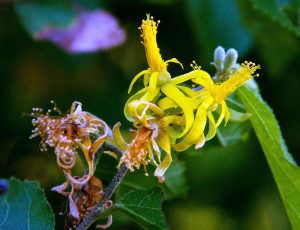
Grewia flavescens var.clukondae. Photo: Bart Wursten. Source: Flora of Zimbabwe
A special request to look properly at a baobab lead us first to a collapsed but not dead giant within Kim reach, a few green leaves leading us through the key to the proper name Adansonia digitata. Turning from there towards the hills, bejewelled Gardenia resiniflua caught the early morning sunlight. Further on Grewia flavescens var. clukondae provided interesting contrast with Grewia bicolour with its leaves softly velvety, and white underneath. Holmaskioldia tettensis proved again to have the spines that we had noted on Sunday. Nearby a fine Balanites maughamii with fluted trunk and conspicuous Y thorny spines we found Dalbergia martini with glandular hairs on the rachis, and Pterocarpus lucens, with the hair like tip at the apex of the leaflets, while Vangueria infausta was less hairy than we expected it to be. A chameleon obligingly changed colour and put on its beware of this fierce creature face for the camera – if Viv does not enjoy these creatures, some of us do not enjoy large spiders and their webs in our path. Shortly after this we puzzled over the browny transparent spots or pockmarks on the leaves of a Combretum – confirmed as C. albopunctatum, and looked at C. celastroides which held masses of small goldy brown fruit, later we saw Meiostemon tetrandrus also full of small, pale, papery 4 winged fruit. Everywhere we met Terminalia prunioides, its 2 winged fruit turning maroon and purple, but perhaps most interesting was Schrebera trichoclada, decorated all about with little wooden pear fruit. Above us on a mound beneath some large leafless pink trunked Sterculia africana our good ‘londa’ announced the arrival of a strange bearded male, having heard them earlier, a lion we wondered, or a poacher? No it was another tree lover come to join us for this last day, and his useful throwing ability he added to our expedition.
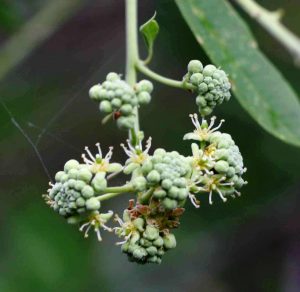
Boscia angustifolia. Photo: Bart Wursten. Source: Flora of Zimbabwe
Anisotes bracteatus the shrub that held flower heads in green and white, not unlike the gardener’s shrimp plant, Beleperone guttata, ranged up the hill slope and then a large tree almost blocked our path, a few feather-fine leaves leading us to Albizia, but which, brevifolia or harveyi?? Our new bearded member knocked down a seed pod but sadly it fell into a thicket of Acacia ataxacantha and was lost to us. Lonchocarpus bussei in various parts of the hill showed a large variation in leaf size, but the swelling on the centre stalk at the point of attachment of the terminal leaflet, and the stipules paired at the bases of petiolules and terminal leaflet, were to be seen clearly. Near the crest of the ridge were a fine Strychnos madagascariensis with smooth grey bark, not powdery, and Boscia angustifolia, with very white smooth truck.
At this point we took a short break to enjoy the view, looking right across the valley floor to the Zimbabwe escarpment in front of us, the river curving and re-curving on our left hand side from the far point where it emerges from the Kariba gorge where we had lunch on Sunday, and the Zambian escarpment beyond half hidden by the hills at our backs. Canoes carrying happy travelers slipped downstream, far away an aeroplane flashed in the sunlight, an eagle floated high above the valley floor on quiet wings. And the heart stopped to think how short a while ago in earth’s time it was since Livingstone and his expedition first mapped and botanised in this area, how even as children we were given to think it was too dangerous an area for pleasure, because of the tsetse flies and mosquitoes and yet here we were drinking in the beauty of this wild corner, untroubled and unafraid. It is perhaps this awareness of time and human history and the fragility of our environment in the face of man’s inexorable urge to overcome obstacles, that make such moments priceless beyond measure, poignant, urgent – how long can we keep these areas safe from our selves. Our otherwise cheerful ‘londa’ rejoiced whenever he saw a tsetse trap destroyed by elephant, for these traps threaten the valley with man’s increased intrusion and destructive powers. Share it, of share the beauty and the threat, the wild call of the hornbills, the giant tamarind’s shade, the jewelled gardenia, lead others to the quest for its meaning, to the determination to conserve it for their children’s children, and then, we may feel glad that we were on top of a hill at Chirundu on a clear May morning.
Slip-sliding down into the gulley below, we met with a beautiful large Commiphora caerulea its trunk clearly showing the milky turquoise-blue under bark. Croton manyhartii crowded down the sides, their leaves guilt tinted underneath and not as aromatic as the Lavender croton that we know better. Strychnos potatorum kept some busy whilst others keyed out a large graceful tree to Cordyla africana, and then on the other side of the gulley Cordia goetzei with its rather succulent leaves, squarish trunk and smooth peeling bark (like a guava tree). And then, oh dear, one of those precipitous vertiginous, do not think about falling stretches, when its good to have the bearded stranger’s helping hand, and thank goodness that is over. Distraction welcome, a puzzle Combretum – is it C. apiculatum do the leaves have a varnished shine, or is it C. zeyheri – because the veining seems more like that – in the end we agreed on the first choice. More large Strychnos madagascariensis, Boscia angustifolia, S. matabelensis, bushy and in full bloom kept us happy until we came across mystery Commiphora – large tree, but the bark was wrong for marlothii or caerulea, and no whole leaves were available for keying.
By this time, hunger became dominant, and like donkeys on the homeward run we headed for camp, to find that it had been besieged and raided by a large, persistent baboon who moved away slowly when he saw our party come in. Brunch was good, at eleven plus in the morning, and then it was a quiet spell for checking specimens whilst our good ‘londa’ went for fuel and try to contact the National Parks staff about the baboon. On his return he took some with him for a swim in the Zambezi, some enjoyed a quiet hour of conversation, and some keen souls worked with the key on trees in the camp
Then tea and an afternoon walk, this time to a dry river bed, and on the way we met up with another of the large mystery Commiphora’s a few almost dry leaves lay around, and our bearded member managed to knock down some seed – have we an answer yet? Strophanthus kombe nearby puzzled us as we worked through the key, but not producing copious transparent sap, but we did see the paired horn like fruit. Hippocrates buchananii carried many of its boat shaped fruit, some splitting to reveal the two winged seeds. In the sandy river bed was Combretum kirkii, a climber but almost tree like, with very large fruit, while nearby C. obovatum showed some of the white leaves and 5 winged fruit that distinguish it (easy, if we’d remember that). Cordia pilosissima with its densely furry leaves was checked against the key, whilst Acalypha ornata and Dombeya kirkii barely a meter apart, were easy to compare and further definition could be added into the key, after examination of the 3 veins on the leave backs.
Berchemia discolour was being examined for comparison of the leaf venation with that of Combretum zeyheri when a growl was heard and it seemed wise to move on. After a wide sweep along the bank and back through an area of Acacia ataxacantha with sunset approaching a contentedly tired group enjoyed the homeward stretch, having been stimulated by working through the key and had the satisfaction of reaching positive answers to the question, what tree is that?
The day rounded off with good food, good company, the night call of a heron and an owl sometimes the distant roar of a lion, and yet being able to sleep in security in the chalets, how glad we all were to have been able to share this experience. And how much we admire the Hunters’ Association for making this kind of experience possible for some of the new generation who will, one day, take their positions in Zimbabwe, enriched and enthusiastic for the cause of conserving these previous wild areas. My deep personal thanks go too, to Kim and Meg for all the work done in preparing the copies of the key for us, for arranging the expedition and for the stimulus and pleasure given to us as a result.
-Ann Bianchi
DICK HICKS CHAIRMAN


